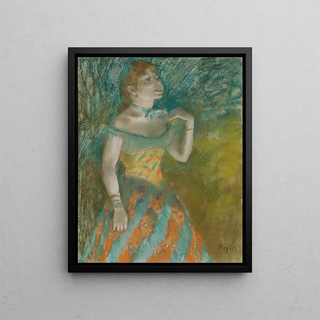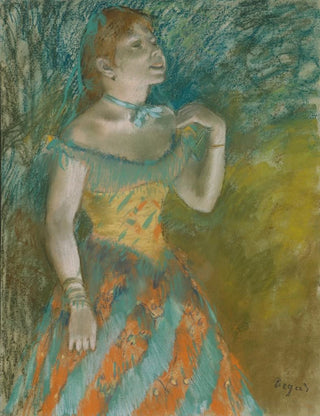Painting The Green Singer - Edgar Degas | Art print


View from behind

Frame (optional)
In the fascinating universe of art, certain works transcend the simple frame to become witnesses of an era, reflections of emotions, and explorations of the human condition. "The Singer in Green" by Edgar Degas perfectly fits into this category. This painting, created at the end of the 19th century, captures not only the essence of a musical moment but also the intimacy of a performance, offering the viewer a privileged glimpse into a thriving artistic world. The scene, vibrant with life, highlights a singer whose expression and gesture are both powerful and delicate, while the bright green of his costume irresistibly draws the eye. This work, at the crossroads between painting and dance, evokes an atmosphere of sophistication and passion, paying homage to the art of performance.
Style and uniqueness of the work
Edgar Degas's style is recognizable among a thousand, and "The Singer in Green" is a perfect illustration of this. The artist, often associated with Impressionism, distinguishes himself by his ability to capture movement and light in a unique way. In this piece, the brushstrokes are both fluid and precise, creating a dynamic that seems to animate the singer. The composition, skillfully arranged, plays on contrasts between vivid colors and delicate shadows, emphasizing the presence of the protagonist at the center of the canvas. Degas, a master of color, uses green not only as a costume hue but as a symbol of vitality and energy. The choice of angles and perspectives, typical of his style, invites the viewer to enter the intimacy of the scene, to feel the raw emotion emanating from this performance. Every detail, from the expressive face of the singer to the subtle movements of the spectators, testifies to meticulous observation and rare artistic sensitivity.
The artist and his influence
Edgar Degas, born in 1834 in Paris, is one of the emblematic figures of modern art. His career, marked by a constant exploration of themes of dance, music, and daily life, has profoundly influenced the development of

Matte finish

View from behind

Frame (optional)
In the fascinating universe of art, certain works transcend the simple frame to become witnesses of an era, reflections of emotions, and explorations of the human condition. "The Singer in Green" by Edgar Degas perfectly fits into this category. This painting, created at the end of the 19th century, captures not only the essence of a musical moment but also the intimacy of a performance, offering the viewer a privileged glimpse into a thriving artistic world. The scene, vibrant with life, highlights a singer whose expression and gesture are both powerful and delicate, while the bright green of his costume irresistibly draws the eye. This work, at the crossroads between painting and dance, evokes an atmosphere of sophistication and passion, paying homage to the art of performance.
Style and uniqueness of the work
Edgar Degas's style is recognizable among a thousand, and "The Singer in Green" is a perfect illustration of this. The artist, often associated with Impressionism, distinguishes himself by his ability to capture movement and light in a unique way. In this piece, the brushstrokes are both fluid and precise, creating a dynamic that seems to animate the singer. The composition, skillfully arranged, plays on contrasts between vivid colors and delicate shadows, emphasizing the presence of the protagonist at the center of the canvas. Degas, a master of color, uses green not only as a costume hue but as a symbol of vitality and energy. The choice of angles and perspectives, typical of his style, invites the viewer to enter the intimacy of the scene, to feel the raw emotion emanating from this performance. Every detail, from the expressive face of the singer to the subtle movements of the spectators, testifies to meticulous observation and rare artistic sensitivity.
The artist and his influence
Edgar Degas, born in 1834 in Paris, is one of the emblematic figures of modern art. His career, marked by a constant exploration of themes of dance, music, and daily life, has profoundly influenced the development of
12,34 €






